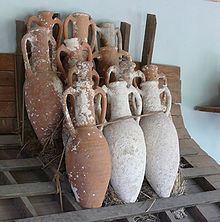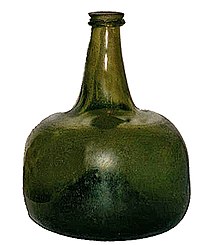Aging of wine

The
History

The

Following the
Aging potential
There is a widespread misconception that wine always improves with age,[3] or that wine improves with extended aging, or that aging potential is an indicator of good wine. Some authorities state that more wine is consumed too old than too young.[5] Aging changes wine, but does not categorically improve it or worsen it. Fruitiness deteriorates rapidly, decreasing markedly after only 6 months in the bottle.[5] Due to the cost of storage, it is not economical to age cheap wines, but many varieties of wine do not benefit from aging, regardless of the quality. Experts vary on precise numbers, but typically state that only 5–10% of wine improves after 1 year, and only 1% improves after 5–10 years.[3][5]
In general, wines with a low
After aging at the winery most wood-aged ports, sherries,
Little to no aging potential
A guideline provided by Master of Wine Jancis Robinson[5]
- QBAs(Qualitätswein bestimmter Anbaugebiete)
- Spumante
- Rosé and blush wines like White Zinfandel
- Branded wines like Yellow Tail, Mouton Cadet, etc.
- European table wine
- jug & box wine
- Inexpensive varietals (with the possible exception of Cabernet Sauvignon)
- The majority of Vin de pays
- All Nouveau wines
- Vermouth
- Basic Sherry
- Tawny Ports
- Kit wines made from mostly concentrated grape juice[10]
Good aging potential
Master of Wine Jancis Robinson provides the following general guidelines on aging wines. Note that vintage, wine region and winemaking style can influence a wine's aging potential, so Robinson's guidelines are general estimates for the most common examples of these wines.[5]
- Botrytized wines(5–25 yrs)
- Chardonnay (2–6 yrs)
- Riesling (2–30 yrs)
- Hungarian Furmint(3–25 yrs)
- Loire Valley Chenin blanc (4–30 yrs)
- Hunter Valley Sémillon(6–15 yrs)
- Cabernet Sauvignon (4–20 yrs)
- Merlot (2–10 yrs)
- Nebbiolo (4–20 yrs)
- Pinot noir (2–8 yrs)
- Sangiovese (2–8 yrs)
- Syrah (4–16 yrs)
- Zinfandel (2–6 yrs)
- Classified Bordeaux(8–25 yrs)
- Burgundy(8–25 yrs)
- Aglianico from Taurasi (4–15 yrs)
- Bairrada(4–8 yrs)
- Hungarian Kadarka (3–7 yrs)
- Melnik(3–7 yrs)
- Croatian Plavac Mali (4–8 yrs)
- Georgian Saperavi (3–10 yrs)
- Madiran Tannat(4–12 yrs)
- Spanish Tempranillo(2–8 yrs)
- Xynomavro(4–10 yrs)
- Vintage Ports (20–50 yrs)[11]
Factors and influences
Wine constituents
The ratio of
In winemaking, the duration of

Storage factors
The storage condition of the bottled wine will influence a wine's aging. Vibrations and heat fluctuations can hasten a wine's deterioration and cause adverse effect on the wines. In general, a wine has a greater potential to develop complexity and more aromatic bouquet if it is allowed to age slowly in a relatively cool environment. The lower the temperature, the more slowly a wine develops.
Wines packaged in large format bottles, such as magnums and 3
Bottling factors
Bottle shock
One of the short-term aging needs of wine is a period where the wine is considered "sick" due to the trauma and volatility of the bottling experience. During bottling the wine is exposed to some oxygen which causes a domino effect of chemical reactions with various components of the wine. The time it takes for the wine to settle down and have the oxygen fully dissolve and integrate with the wine is considered its period of "bottle shock". During this time the wine could taste drastically different from how it did prior to bottling or how it will taste after the wine has settled. While many modern bottling lines try to treat the wine as gently as possible and utilize inert gases to minimize the amount of oxygen exposure, all wine goes through some period of bottle shock. The length of this period will vary with each individual wine.[2][5]
Cork taint
The transfer of
Dumb phase
During the course of aging, a wine may slip into a "dumb phase" where its aromas and flavors are very muted. In Bordeaux this phase is called the age ingrat or "difficult age" and is likened to a
Effects on wine

As red wine ages, the harsh tannins of its youth gradually give way to a softer
During the aging process, the perception of a wine's acidity may change even though the total measurable amount of acidity is more or less constant throughout a wine's life. This is due to the
As a wine starts to mature, its bouquet will become more developed and multi-layered. While a taster may be able to pick out a few fruit notes in a young wine, a more complex wine will have several distinct fruit, floral, earthy, mineral and oak derived notes. The lingering finish of a wine will lengthen. Eventually the wine will reach a point of maturity, when it is said to be at its "peak". This is the point when the wine has the maximum amount of complexity, most pleasing mouthfeel and softening of tannins and has not yet started to decay. When this point will occur is not yet predictable and can vary from bottle to bottle. If a wine is aged for too long, it will start to descend into decrepitude where the fruit tastes hollow and weak while the wine's acidity becomes dominant.[4]
The natural esterification that takes place in
Coates’ Law of Maturity
Coates’ Law of Maturity is a principle used in wine tasting relating to the aging ability of wine. Developed by the
Example
An example of the principle in practice would be a wine that someone acquires when it is 9 years of age, but finds dull. A year later the drinker finds this wine very pleasing in texture, aroma and mouthfeel. Under the Coates Law of Maturity the wine will continue to be drunk at an optimal maturation for that drinker until it has reached 20 years of age at which time those positive traits that the drinker perceives will start to fade.[13]
Artificial aging
There is a long history of using artificial means to try to accelerate the natural aging process. In
See also
References
- ^ ISBN 978-0123736468.
- ^ ISBN 978-1-4419-5190-8.
- ^ a b c Windows on the World Wine School: Frequently Asked Questions Archived 2014-12-25 at archive.today, Kevin Zraly:
Q. Are all wines meant to be aged?
KZ: No. It's a common misconception that all wines improve with age. In fact, more than 90 percent of all the wines made in the world are meant to be consumed within one year, and less than 1 percent of the world's wines are meant to be aged for more than 5 years. - ^ ISBN 0-19-860990-6.
- ^ ISBN 0-7892-0883-0.
- ^ Vintage Champagne, Giles Fallowfield, Square Meal Magazine Spring 2006.
- ^ McInerney, Jay (October 1, 2011). "The 1996 Champagnes: Great, but Just How Great?".
- ^ "Old Champagne". rarewineco.com. Retrieved 2015-10-28.
- ^ Julian Joyce (20 March 2009). "World's oldest champagne opened". BBC News Online.
- ^ "Deciphering the differences between kits". Creative Connoisseur. May 2004.
- ISBN 978-0-7432-7199-8.
- ^ ISBN 1-56305-434-5.
- ^ ISBN 0-7566-1324-8.
- ISBN 9780671687021.
- ^ Stephanie Pain (17 December 2008). "How to make cheap wine taste like a fine vintage". New Scientist (2687).
- ^ "Clef du Vin: Best Wine Gadget Ever, Or Just Another Expensive One?". mattura.com. Archived from the original on 2010-04-14. Retrieved 2015-10-28.
- ^ "Here's why wine makers are ageing their bottles under the sea". Hindustan Times. July 5, 2018. Retrieved February 19, 2020.
Further reading
- Suriano, Matthew, "A Fresh Reading for 'Aged Wine' in the Samaria Ostraca," Palestine Exploration Quarterly, 139,1 (2007), 27–33.
External links
- Felicien Breton (2008). "Storage conditions for keeping wine". Retrieved 2015-10-28.
- Alexander J. Pandell, Ph. D (1996). "How storage temperature affects the aging of wines". Archived from the original on 2016-03-04. Retrieved 2015-10-28.
- "Deciphering the differences between kits". 2009. Retrieved 2015-10-28.
